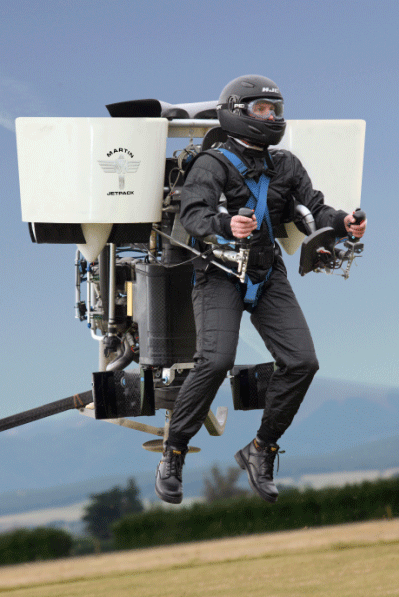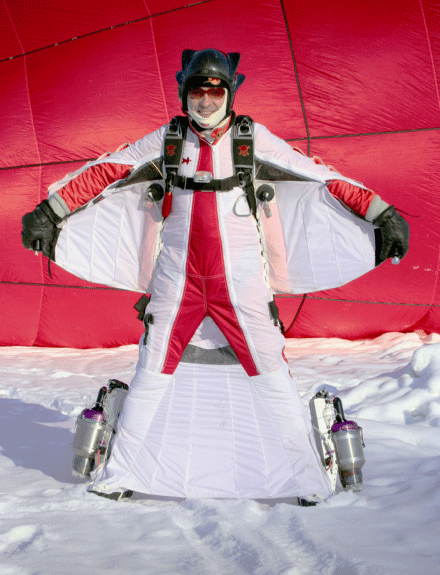Transforming the science fiction fantasy of personal flying into reality is closer than ever - but can jetpack pioneers make the final leap? We take a festive flight through some of the quirkier - but just about believable - ideas for revolutionising air travel
After four decades of snail-pace development, jetpack technology is now rocketing skyward. New concepts making use of strap-on devices promise to make age-old dreams of personal flying come true and have leapfrogged hydrogen peroxide-powered rocket belts, which had been at the forefront of research.
The closest product to delivery is the Jetpack, under development by New Zealand-based Martin Aircraft. A jetpack is the common term for a fuel-burning device that people can attach to themselves and use to fly. Purists would call it a personal helicopter - the US Federal Aviation Administration classifies the Martin Jetpack as an experimental ultralight aircraft. The Jetpack's 200hp (150kW) Martin V4 ducted fan was developed to provide 600lb of thrust (2.7kN) to twin blades of the torque-neutral fan system, which draw petrol from a 140 litre (5USgal) tank
RESTRICTED FLIGHTS
The 125kg (280lb) unit stands upright on the ground behind pilots, who must weigh at least 60kg and no more than 125kg. By next year the device might fly for 30min at 87kt (160km/h) and altitudes of 8,000ft (2,440m). "To date our longest flight is around 4min, and this used less than 20% of a tank of gasoline," says Martin chief executive Richard Lauder. "Until we are satisfied with our work on the safety-related tasks, and have completed 100h of incident-free flying, it is company policy to restrict all flights to low altitudes. So none of our pilots have gone more than 10ft off the ground."
A pair of joysticks extends in front of the pilot to control throttle and pitch. The tallest point on the composite and kevlar structure is a v-shaped fairing to protect the head and neck in case of an accident.
| |
 |
|---|
|
© Martin AircraftThe Martin Jetpack could be on the market towards the end of 2009 |
Customers putting $10,000 down on the $100,000 device intend to use it for search and rescue, videography - and to have fun. "To date we have had no serious enquiries from the military," says Lauder. Before the first delivery in the second half of 2009, he says, "we are completing development work on electronic stability, fitting and testing the BRS ballistic parachute, and completing some reliability engineering tasks." The device was designed over 30 years by New Zealand biochemist Glenn Martin. Two weeks of training come with each purchase, although as it is an ultralight it may not be necessary to hold a pilot's licence, depending on a particular country's regulations.
One of the Jetpack's rivals has gone further. Switzerland's "Fusion Man" Yves Rossy flew his Jet Wing across the English Channel in September in 9min. "I had a good tail wind," he recalls, which boosted him to 130kt.
Rossy wears a heat-resistant suit and helmet and uses small adjustments to his body as control surfaces. A hand throttle links to the four jet engines developed by California-based JetCat, which makes model aircraft powerplants.
SAFETY FIRST
"At sea level, full thrust is 7 decilitres per minute per engine, and it gives 48lb of thrust," he says. Rossy makes no price predictions for the unit and nor will he say when it may go on sale. "Before you sell something you have to create something that is safe," he says. No other pilot has yet flown it. His sponsors, primarily Swiss watchmaker Hublot, have spent $285,000 to construct the Fusion Man wing.
Rossy has requested three years of leave from his pilot duties at Swiss International Air Lines to continue development and performances. He has been invited to fly at the Experimental Aircraft Association's AirVenture show in Oshkosh next July.
"With the next prototype I expect better climb, almost vertical," he says. "Actually, I could take off from the ground now. I just need efficient wind - for example a catapult or a car roof at 150km/h or 160km/h." Currently he leaps out of the local skydiving club's Pilatus Porter before unfolding his 2.4m wing and powering up. Thirty litres of kerosene runs out after 13min and a parachute opens out of the wing for landings.
Enhanced performance is "more to explore flight domain", Rossy says. As long as he stays above the stall speed of 90kt he loves every moment, controlling flight "with arching, and bending down, twisting your arms forward". It is not tiring, he adds, "because it's completely balanced. I have no forces at all. I am hanging a little bit in the harness, but very much sustained by the air pressure on my body, so it's just a little bit on the lower back. I couldn't really do it for hours, but 20min is no problem."
Holding the best position is a significant obstacle for Visa Parviainen as custom boot jets propel his "BirdMan" suit above Finland. "We have combined a wingsuit and jet engines," he says. He dives from hot air balloons with the goal of attaining level flight. The cloth stretching from the arms and legs of his suit slow his decent to 1,970ft/min (10m/s), and the thrust from each boot slows that to 590ft/min.
 |
|---|
© Juge Heikkila"BirdMan" Visa Parviainen has combined a wingsuit and jet engines |
"You launch very easily with your head down," Parviainen says. "Then, when you get some airflow, you start to stabilise and at that moment I start to throttle up. It takes about 300-400m of altitude to get it flying well, and after that it feels very much like the normal wings would fly. Keeping flying position is quite hard. If you point your thrust a little differently it changes everything a lot." Ideally, the boots point straight behind him.
"We have put the rpm limit a little higher and are getting close to 30kg of thrust each," he adds. "The engines are fitted on the side of my legs and attached to the skate boot. It's very lightweight, but still leaves some movement to your ankle." Fuel lines feed from 5 litre bladders tucked in each arm wing. "It collapses when you use all of the fuel, so it's safe and easy. Controls are fitted to my hands. In my left hand I have the throttle and in the right hand I have a deadman's switch, which I have to keep pressed all the time," he says. A parachute is deployed for landing.
So far Parviainen has held powered flight for 1.7km. "Commercially, I don't see a near future. I'm not too optimistic on that," he says.
The first flight of Jet Pack International's turbine-powered T-73 is more than a year away, says Troy Widgery, founder of the Denver, Colorado-based company. Widgery aims to burst through the brief time limits of traditional rocket belts. "It will have three turbines, just like a little jet turbine. It'll cost about $200,000 to buy it. That'll include training. You can't just sell one of these to an average person, they'll kill themselves," he warns.
A fit pilot weighing no more than 80kg would need strong legs to manage the 65kg backpack and to land with fuel in the tank, unless they exhaust the 9min supply. "They could go thousands of feet [upward], no problem, but most people aren't going to go more than a couple feet off the ground," Widgery predicts. The T-73 is designed to reach 70kt and have a range of 18km (9nm). "It'll look like you would think a jetpack would look," he says. "It's a different type of loud, but it's extremely loud, and a sustained noise." Fuel is cheaper than the $2,000 cost for each hydrogren peroxide-powered rocket belt flight.
NO PARACHUTE
No parachute is planned for any of these systems, although the company's pilot says he uses "a prayer-chute", which was the back-up safety system for Eric Scott as he broke the flight duration and height record in November. That record has crept up by just 10s in the past four decades. Scott's 33s flight stretched 460m over a gorge and the Arkansas river 1,053ft below. Jet Pack is also developing the H202-Z for 45s of flight time. This product has a lighter carbonfibre design.
Dan Schlund of rocketman.org does not imagine a mainstream market for rocket-powered personal flight. "Learning to fly is very difficult despite what a lot of people say. There's a reason why there's only been 11 of us to fly these," he points out.
The Bell Rocket Belt is the forefather of modern rocket belts, but Bell has long shelved its own plans, along with the rocket-powered POGO platforms it designed for NASA.
Tecnologia Aeroespacial Mexicana also markets a rocket belt and plans to add a backpack helicopter called the Libellula. "This will be the lightest helicopter in the world, so light that you strap it to your body with a carbonfibre corset," the company says.
It pays homage to Austrian Paul Baumgartl, who designed a strap-on helicopter in the 1940s, and Eugene Gluhareff, who flew his single-blade MEG-2X 20 years later.
The Libellula borrows an idea from Stanley Hiller that was later proven by the Intora Firebird mini helicopter during demonstration flights in 1998. Rocket exhausts from the tips of the twin rotor power the spin.
But with most devices barely into infancy or not intended to come to market at all, do not expect to be able to turn science fiction into reality and go rocketing skywards from your back garden just yet.
Source: Flight International
















